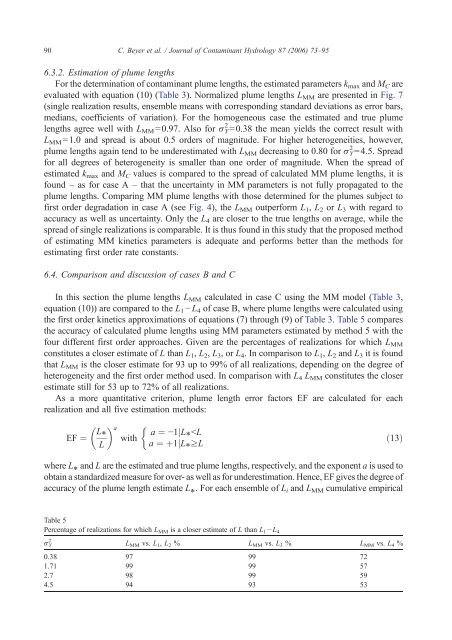Applied numerical modeling of saturated / unsaturated flow and ...
Applied numerical modeling of saturated / unsaturated flow and ...
Applied numerical modeling of saturated / unsaturated flow and ...
Create successful ePaper yourself
Turn your PDF publications into a flip-book with our unique Google optimized e-Paper software.
90 C. Beyer et al. / Journal <strong>of</strong> Contaminant Hydrology 87 (2006) 73–95<br />
6.3.2. Estimation <strong>of</strong> plume lengths<br />
For the determination <strong>of</strong> contaminant plume lengths, the estimated parameters kmax <strong>and</strong> MC are<br />
evaluated with equation (10) (Table 3). Normalized plume lengths LMM are presented in Fig. 7<br />
(single realization results, ensemble means with corresponding st<strong>and</strong>ard deviations as error bars,<br />
medians, coefficients <strong>of</strong> variation). For the homogeneous case the estimated <strong>and</strong> true plume<br />
lengths agree well with LMM=0.97. Also for σY 2 =0.38 the mean yields the correct result with<br />
L MM=1.0 <strong>and</strong> spread is about 0.5 orders <strong>of</strong> magnitude. For higher heterogeneities, however,<br />
plume lengths again tend to be underestimated with L MM decreasing to 0.80 for σ Y 2 =4.5. Spread<br />
for all degrees <strong>of</strong> heterogeneity is smaller than one order <strong>of</strong> magnitude. When the spread <strong>of</strong><br />
estimated kmax <strong>and</strong> MC values is compared to the spread <strong>of</strong> calculated MM plume lengths, it is<br />
found – as for case A – that the uncertainty in MM parameters is not fully propagated to the<br />
plume lengths. Comparing MM plume lengths with those determined for the plumes subject to<br />
first order degradation in case A (see Fig. 4), the LMM outperform L1, L2 or L3 with regard to<br />
accuracy as well as uncertainty. Only the L4 are closer to the true lengths on average, while the<br />
spread <strong>of</strong> single realizations is comparable. It is thus found in this study that the proposed method<br />
<strong>of</strong> estimating MM kinetics parameters is adequate <strong>and</strong> performs better than the methods for<br />
estimating first order rate constants.<br />
6.4. Comparison <strong>and</strong> discussion <strong>of</strong> cases B <strong>and</strong> C<br />
In this section the plume lengths LMM calculated in case C using the MM model (Table 3,<br />
equation (10)) are compared to the L1 −L4 <strong>of</strong> case B, where plume lengths were calculated using<br />
the first order kinetics approximations <strong>of</strong> equations (7) through (9) <strong>of</strong> Table 3. Table 5 compares<br />
the accuracy <strong>of</strong> calculated plume lengths using MM parameters estimated by method 5 with the<br />
four different first order approaches. Given are the percentages <strong>of</strong> realizations for which LMM<br />
constitutes a closer estimate <strong>of</strong> L than L1, L2, L3, orL4. In comparison to L1, L2 <strong>and</strong> L3 it is found<br />
that LMM is the closer estimate for 93 up to 99% <strong>of</strong> all realizations, depending on the degree <strong>of</strong><br />
heterogeneity <strong>and</strong> the first order method used. In comparison with L4 LMM constitutes the closer<br />
estimate still for 53 up to 72% <strong>of</strong> all realizations.<br />
As a more quantitative criterion, plume length error factors EF are calculated for each<br />
realization <strong>and</strong> all five estimation methods:<br />
EF ¼ L *<br />
L<br />
a<br />
with<br />
a ¼ −1jL * bL<br />
a ¼þ1jL * zL<br />
where L ⁎ <strong>and</strong> L are the estimated <strong>and</strong> true plume lengths, respectively, <strong>and</strong> the exponent a is used to<br />
obtain a st<strong>and</strong>ardized measure for over- as well as for underestimation. Hence, EF gives the degree <strong>of</strong><br />
accuracy <strong>of</strong> the plume length estimate L ⁎. For each ensemble <strong>of</strong> Li <strong>and</strong> LMM cumulative empirical<br />
Table 5<br />
Percentage <strong>of</strong> realizations for which LMM is a closer estimate <strong>of</strong> L than L1−L4<br />
LMM vs. L1, L2 % LMM vs. L3 % LMM vs. L4 %<br />
0.38 97 99 72<br />
1.71 99 99 57<br />
2.7 98 99 59<br />
4.5 94 93 53<br />
σ Y 2<br />
ð13Þ

















